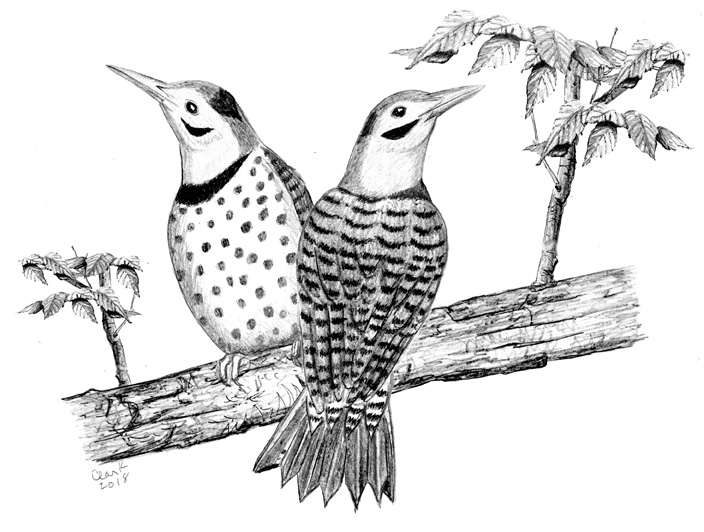
Dear Bird Folks,
I’m wondering if you could explain a strange bird behavior I witnessed today. Two flickers were in my backyard and at first they were just staring at each other. Then they both began swaying back and forth, as if they were dancing. Was this a courting ritual?
– Ann, Dennis Port, MA
Let me get this straight, Ann,
You claim to have seen a pair of birds “dancing” in your backyard. Really? This wasn’t on 4/20, was it? What about pink elephants? Did you happen to see any of those, too? Oh, I’m just teasing. I know exactly what you saw. It’s called (and I’m not kidding this time) the “flicker dance.” The flicker dance is a fairly common occurrence, although most folks aren’t lucky enough to witness it. While it can happen any time of year, this dance most often occurs in the spring, right around prom time. Coincidence? I don’t think so, but let’s find out.
Before I explain this dance thing, I should first tell you a few peculiar things about flickers. (Try to pay attention, because it’s complicated.) Here in the East we have the “yellow-shafted flicker,” while the folks out West have a slightly different bird called the “red-shafted flicker.” For years, officials thought these were two distinctly separate species. Then someone noticed that when the red-shafted and the yellow-shafted flickers met each other they would breed. This meant that the two birds were actually one single species, not two. So, the officials had to come up with a name for this “new” bird. They chose to call both birds “Northern Flickers,” and don’t ask me why. You just need to know that the information in the rest of this column refers to the Eastern form of this species, aka, yellow-shafted flicker, aka, Northern Flicker, aka, I told you it was complicated.
Here’s something else about flickers you might not know: they are actually woodpeckers. In fact, they are the largest woodpeckers seen on Cape Cod and the second largest in North America. Breeding from Florida to Alaska, and everywhere in between, flickers are the most widespread and the most common of our woodpeckers. Yet, despite being woodpeckers, they don’t “peck” a lot of wood. Most of their time is spent on the ground searching for ants. In fact, flickers eat more ants than any other North American bird. (Be sure to mention that last piece of information at your next cocktail party. It will totally impress everyone…maybe.)
With some woodpecker species, such as Downy Woodpeckers for example, it’s fairly easy to distinguish the male from the female. The male downy has a red spot on the back of his head, while the female doesn’t. This is not the case with flickers, as both sexes have red spots. But the males have something the females don’t. They have a black streak, or a “mustache,” on each side of their beaks. The females have no such mustache (or if they do, they cover it with makeup). Ornithologists refer to this mark as a “malar stripe,” but male woodpeckers prefer calling it a mustache. They think it sounds cooler…and a whole lot more manly.
I mention this mustache thing so I can finally discuss your dancing birds. Like most birds, flickers have elaborate courtship displays, but the flicker dance is less about mating and more about territory defense. The dance is most common in the spring, when birds are defending their mates and nesting territories. It typically takes place when a mustached male flicker tries to move into another couple’s territory. The intruder is met by the resident male, who confronts him in a stare-down. The two birds stand a few inches apart, just glaring at each other, with their beaks pointing skyward. At first nothing much happens, but then one bird begins to move its head from side to side, which causes the other bird to do the same thing. Without making contact, they continue to wave their long beaks back and forth. From a distance the birds look like tiny Jedi Masters having a lightsaber duel…especially if seen on 4/20.
As things become more intense, the birds will flash the yellow under their wings and tails, and make their distinctive “wicka, wicka” call. Occasionally, physical contact takes place, but usually one bird gets bored with the whole thing and simply flies away, and the best dancer wins the day. If any of this sounds familiar, it should. I’m pretty sure the Macarena is based on the flicker dance (which is only slightly less annoying at parties).
I’m glad you were able to see that funky flicker interaction, Ann. It’s just too bad humans can’t learn from birds. Instead of squabbling and fighting, we could solve our disputes by simply having a dance-off. The person with the best moves wins. On second thought, that might not be such a good idea for me. If dancing were involved, I would never win another argument.
On a similar topic:
Spring is when flickers and other woodpeckers do quite a bit of “drumming.” The birds drum to announce their territories. Sometimes this drumming is on a distant tree, but other times it can be on a house. The most common remedy for this problem is to place strips of holographic “scare tape” on the problem area. If you don’t have scare tape, you could also climb up on the roof and challenge the bird to a dance-off. But if you do that, be sure to have someone hold the ladder and by all means, have someone record it. YouTube has been boring lately.